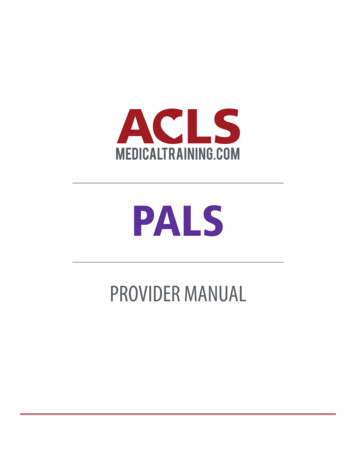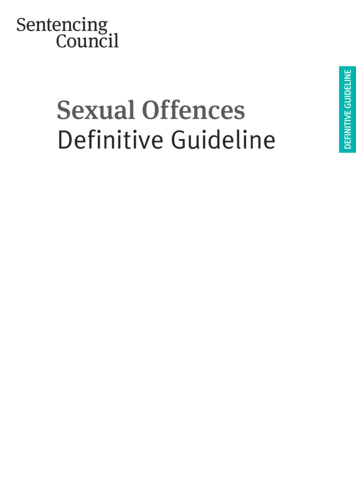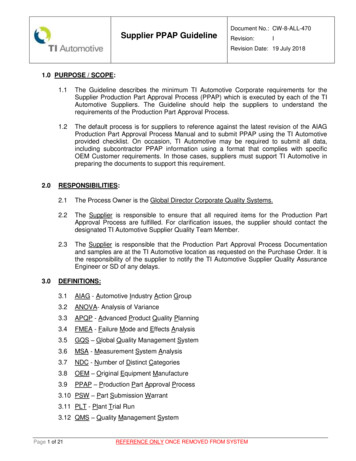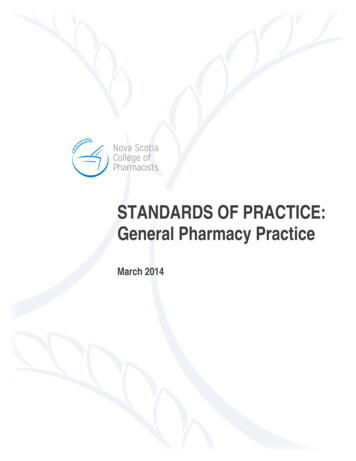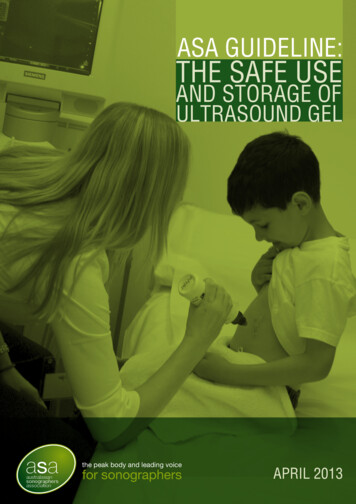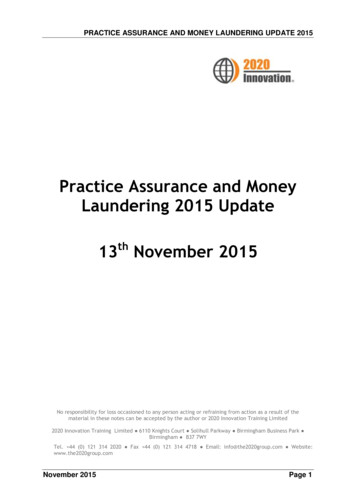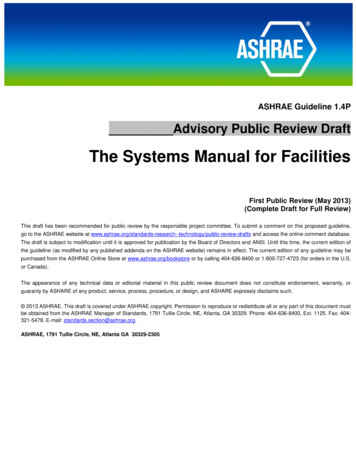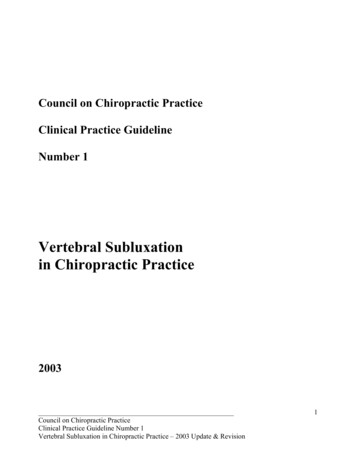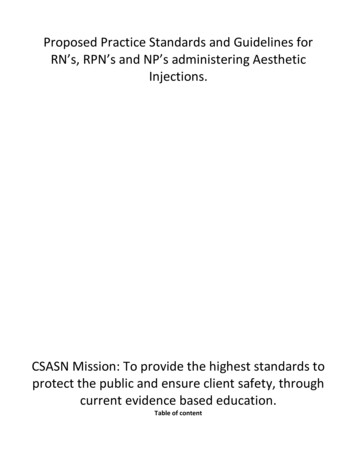
Transcription
Proposed Practice Standards and Guidelines forRN’s, RPN’s and NP’s administering AestheticInjections.CSASN Mission: To provide the highest standards toprotect the public and ensure client safety, throughcurrent evidence based education.Table of content
Acknowledgement . 4Introductions . 51) Ethics. 6Indicators . 6Ethics for the Aesthetic Nurse Injector in a Clinical Practice . 7Canadian Code of Advertising Standards . 7Canadian Food and Drugs Act and Food and Drug Regulations. . 7Food and Drug Regulations. 8Maintaining Privacy and Confidentiality. 8Procedure to Maintain Confidentiality . 9Email communication . 9Canadian Anti Spam Law (CASL) .102) Accountability . 10Regulated Health Professions Act .10Self-Regulation .11Medical Directives.11Qualifications for the Aesthetic Nurse Injector.123) Continued Competence Program . 134) Documentation . 135) Reasons for Documentation . 13To facilitate communication .13To promote good nursing care.15To meet professional and legal standards.156) Directives for Documentation . 157) Electronic Documentation . 158) Tele Nursing . 169) Consent . 1610)Maintenance of Health Records. 1711)Facility Recommendations . 1712)Treatment / Procedure Protocol . 18Neurotoxins .18Dermal Fillers, Volume Enhancers, Collagen Stimulators, Lipolysis injection.1913)Patient Safety . 19Adverse Events .20Canadian Society of Aesthetic Specialty Nurses - 20152 Page
Reporting Adverse Events.20Report adverse events as follows: .20Documentation should include the following: .20The Medical Director should:.20Report any adverse events to the manufacturer’s medical affairs department. .20Complication Guides – Dermal Fillers .21Complication Guides – Inflammatory Nodule / Biofilm .22Complication Guides – Non Inflammatory Nodule / Biofilm .23Complication Guides – Malar Edema .24Complication Guides – Antibody Mediated Edema (Angioedema) .25Complication Guides – Intravascular Incident - Necrosis .26Complication Guides – Retinor Occluson .27Complication Guides – Neurotoxins / Eye lid Ptosis .28Complication Guides – Neurotoxins / Brow Ptosis .2914)Liability . 30Appendix A – Advertising Standards of Canada . 31Appendix B - Continued Competence Program . 33Appendix C - Facility Recommendations . 36References . 39Canadian Society of Aesthetic Specialty Nurses - 20153 Page
AcknowledgementWe would like to acknowledge the members of the task force who dedicated hours of their time todeveloping this document.Yolanda Balatbat RN, BSN- Toronto, OntarioMarcelle Caruana RN, CANS – Toronto, OntarioDeborah Elias RN- Toronto, OntarioRachel Gautreau RN- Moncton, New BrunswickCatherine Gobeil RN – Montreal, QuebecAngela Haff RN- Vancouver, British ColumbiaTracey Hotta RN, BScN, CPSN, CANS – Thornhill, OntarioCynthia Webb RN, CANS- Oakville, OntarioKathryn Woodcock RN, BSBM – Vancouver, British ColumbiaCanadian Society of Aesthetic Specialty Nurses - 20154 Page
IntroductionsWhat are Practice Standards and Guidelines?The provincial nursing colleges produce a number of practice standards and guidelines to supportnurses in providing safe, effective and ethical nursing care. Practice standards outline the expectationsfor nurses that contribute to public protection. They inform nurses of their accountabilities and thepublic of what to expect of nurses. The standards apply to all nurses regardless of their role, jobdescription or area of practice.Practice guidelines help nurses understand their responsibilities, and to make safe and effectivedecisions in their nursing practice.The nursing College / Association practice standards and guidelines for aesthetic nurse injectors areconsistent with the legislation that is proposed in the Nursing Act, 1991, Regulated Health ProfessionsAct, 1991 and Health Care Consent Act.Drafting practice standards is a key function of a self-regulating profession. It is recognized that theanti-aging cosmetic medicine trend is on the rise and requires regulation to ensure these proceduresare restricted to those individuals who are professionally trained and must provide proof that theirskills are being maintained.All practice standards and guidelines apply broadly to the nursing profession and are delivered tonurses within their respective colleges / associations.This document outlines the ethical and clinical standards that all Canadian aesthetic nurse injectorsshould adhere to, keeping ethical and client safety at the forefront of their practice. This document willaddress all the essential parts of an aesthetic non-surgical clinical practice including patient safety,informed consent, education and training, documentation, scope of practice, medical directives / postentry level procedures (PELP) and facility recommendations.This document focuses on the professional standards and competencies that the aesthetic nurseinjector should be expected to demonstrate while providing aesthetic injection procedures. Theaesthetic nurse injectors have the responsibility to practice only in facilities that follow therecommendations outlined in this document.The term aesthetic nurse injector (RN) refers to a registered nurse, registered practical nurse and nursepractitioner who has undergone specific training for the administration of dermal fillers, volumeenhancers, collagen stimulators, lypolisis, and neurotoxins.The client refers to a person who has chosen to undergo a medical aesthetic procedure(s).The medical director is a physician who has undergone specific training for the administration ofdermal fillers, volume enhancers, collagen stimulators, lypolisis, and neurotoxins and is supervising theaesthetic nurse injectors practice.Canadian Society of Aesthetic Specialty Nurses - 20155 Page
1) EthicsEthical nursing care means promoting the values of client well-being, respecting client choice, assuringprivacy and confidentiality, respecting the sanctity and quality of life, maintaining commitments,respecting truthfulness and ensuring fairness in the use of resources. It also includes acting withintegrity, honesty and professionalism in all dealings with the client and other health care teammembers.Nursing Values and Ethical Responsibilities describes the core responsibilities central to ethical nursingpractice. The seven primary values are: Providing safe, compassionate, competent and ethical carePromoting health and well-beingPromoting and respecting informed decision-makingPreserving dignityMaintaining privacy and confidentialityPromoting justiceBeing accountableIndicatorsA nurse demonstrates the ethical standard by: identifying ethical issues and communicating them to the health care team identifying options to resolve ethical issues evaluating the effectiveness of the actions taken to resolve ethical issues identifying personal values and ensuring they do not conflict with professional practiceIn addition, a nurse in an administrator role demonstrates the standard by: creating environments that promote and support safe, effective and ethical practice valuing the time that’s taken to resolve ethical issues advocating for resources and establishing mechanisms to assist nurses in recognizing and resolvingethical issues supporting nurses in developing skills to recognize and manage ethical issues facilitating / advocating for nursing input on ethics committeeA nurse in an educator role demonstrates the standard by: encouraging and supporting critical thinking and dialogue about ethical issues assisting nurses in identifying resources to improve recognition and resolution of ethical issues.Canadian Society of Aesthetic Specialty Nurses - 20156 Page
Ethics for the Aesthetic Nurse Injector in a Clinical PracticeThe aesthetic nurse injector: follows the Ethical standards of the Canadian Nurses Association follows the Confidentiality and Privacy- Personal Health Information standard of the CanadianNurses Association and provincial nursing college / associations practise under the direction of a Medical Director understands the Scope of Practice principles that are mandated for the province the injector islicenced in educates self to keep current in all aspects of the speciality uses only Health Canada approved products, equipment and treatmentsCanadian Code of Advertising StandardsThe Canadian Code of Advertising Standards (Code), which has been developed to promote theprofessional practice of advertising, was first published in 1963. Since that time it has been reviewedand revised periodically to keep it contemporary. The Code is administered by Advertising StandardsCanada (ASC). ASC is the industry body committed to creating and maintaining community confidencein advertising.The Code is broadly supported by industry and is designed to help set and maintain standards ofhonesty, truth, accuracy, fairness and propriety in advertising. The provisions of the Code should beadhered to both in letter and in spirit. Advertisers and their representatives must substantiate theiradvertised claims promptly when requested to do so by Council.Any advertising for aesthetic injections should be for the sole purpose of conveying factual informationto the client. Advertising should not be used for the purpose of conveying additional information,outside of the factual information, that may unduly influence a client’s decision to proceed with thetreatment.The following standards are based on information obtained in the Advertising Standards of Canada,February, 2014. See appendix ACanadian Food and Drugs Act and Food and Drug Regulations.Definition of Advertising“Advertisement includes any representation by means whatever for the purpose of promoting directlyor indirectly the sale or disposal of any food, drug, cosmetic or device”. (Food and Drug Act- 1985) Anyperson who promotes the sale of a specific health product is subject to advertising legislation.Food and Drugs ActCanadian Society of Aesthetic Specialty Nurses - 20157 Page
Section 9(1): Prohibits health product advertising which is false, misleading or deceptive, or is likely tocreate an erroneous impression regarding its character, value, quantity, composition, merit or safety.Examples of possible section 9(1) contraventions: messages which emphasize only product benefitswithout including safety information; and messages discussing off-label use of a product.Section 20(1): Prohibits false, misleading or deceptive advertising of medical devices.Section 3(1): Prohibits consumer-directed ads for health products (including medical devices) whichmake claims to treat, prevent or cure any of the serious diseases listed in Schedule A to the Act(although Schedule A prevention claims are now permitted by regulation for over-the-counter drugsand natural health products).Food and Drug RegulationsSection C.01.044: Prohibits consumer-directed prescription drug advertising beyond the drug’s name,price and quantity. This means that when a prescription drug is advertised by name to consumers, noreference can be made to its therapeutic use and/or benefits.Section C.08.002 (1): Prohibits the advertising of new drugs, which have not been authorized for saleby Health Canada. There shall be no link between the brand name of a medication ie. Botox or Latisse, and theindication (what the drug does) in any advertising to the general consumer. This includes websitesand Facebook page.The website to be informational and not an advertisement or product promoting. There must notbe no links to brand-specific websitesAds that mention a drug name are allowed only if we leave out what the product actually does.You may indicate that you offer neurotoxin treatments (Botox, Xeomin, Dysport) but must notstate what the drug does or substituting the name of the neurotoxin with one of the followingphrases cosmetic injections; anti-wrinkle injections/treatments; wrinkle injections/treatmentsHealth Canada states that you cannot use company pre/post photo’s but actual client photo’s isacceptableBefore and after pictures should be for in-office use only or for communication to our existingclients.Maintaining Privacy and ConfidentialityCanadian Society of Aesthetic Specialty Nurses - 20158 Page
Aesthetic nurse injectors recognize the importance of privacy and confidentiality and safeguardpersonal, family, community information obtained in the context of a professional relationship. Nurseshave an ethical responsibility to safeguard information obtained in the context of the nurse-clientrelationship.Principles of confidentiality Nurses know the legislation that is mandated by their provincial colleges. Nurses share relevant personal and health information with the health care team. Nurses explainto clients that this information will be shared and identify to them who is on the health care team Nurses respect clients' rights to access their own health records Nurses safeguard personal and health information learned in the context of the nurse-clientrelationship and disclose this information (outside of the health care team) only with clientconsent or when there is a specific ethical or legal obligation to do so. Nurses have an ethical obligation to disclose in situations that involve a substantial risk ofsignificant harm to the health or safety of the client or others. This process involves consultingwith the medical director Nurses comply with any legal obligation to disclose confidential information that is imposed byprovincial legislation. In all cases where disclosure of confidential information is necessary, nurses restrict the amount ofinformation disclosed and the number of people informed to the minimum necessary to fulfill thelegal and ethical obligations.Procedure to Maintain Confidentiality All staff to sign a confidentiality agreement upon employmentStore client records safely and securely. Take special care when transporting client records toensure they are not lost, stolen or accessed by unauthorized persons.Keep client information confidential when transmitting information through fax; avoid using clientnames if possible; check fax number and mark "Confidential" before sending). Ensure there is apolicy in place regarding a secure transmittal system.Electronic documentation carries a higher risk of breach of confidentiality. Policies and procedures,as well as specific technologies, are required to protect the confidentiality of the patient’s healthrecord and system security.If computerized charting is used, follow your organization's policies to ensure the privacy andsecurity of the information (e.g., use passwords as directed; log off when leaving the computer).Ensure that client information displayed on a computer monitor remains confidential (e.g., use ascreen saver; locate the monitor in a secure area).Email communicationCanadian Society of Aesthetic Specialty Nurses - 20159 Page
Guidelines for protecting client confidentiality when using e-mail to transmit client information are asfollows: obtain written consent from the client when transferring health information by e-mail transmit e-mail using special security software (e.g., encryption, user verification or secure pointto-point connections) include a confidentiality warning indicating that the information being sent is confidential and thatthe message is only to be read by the intended recipient and must not be copied or forwarded toanyone else never forward an e-mail received about a client without the client’s written consent maintain confidentiality of all information, including that reproduced in hard copy locate printers in secured areas away from public access establish a policy and protocol for a secure and confidential e-mail systemsCanadian Anti Spam Law (CASL)Canadian Anti Spam Law will help to protect Canadians while ensuring that businesses can continue tocompete in the global marketplace.This law will generally prohibit the: sending of commercial electronic messages without the recipient's consent (permission), includingmessages to email addresses and social networking accounts, and text messages sent to a cellphone; alteration of transmission data in an electronic message which results in the message beingdelivered to a different destination without express consent; installation of computer programs without the express consent of the owner of the computersystem or its agent, such as an authorized employee; use of false or misleading representations online in the promotion of products or services; collection of personal information through accessing a computer system in violation of federal law(e.g. the Criminal Code of Canada); and collection of electronic addresses by the use of computer programs or the use of such addresses,without permission (address harvesting).2) AccountabilityCollaboration of the medical aesthetic team requires effective and efficient communication betweenall team members so that specific roles can be identified. The medical director and aesthetic nurseeach practice within their own professional scope of practice, but work as a team to provide care andthey collectively share responsibility for the outcomes. Clearly established Scopes of practice helpmitigate accountability risks within collaborative practices of regulated health professionals.Regulated Health Professions ActThe scope of practice model is set out in the Regulated Health Professions Act and consists of twoelements:Canadian Society of Aesthetic Specialty Nurses - 201510 P a g e
Scope of practice statementControlled actsNursing’s Scope of Practice StatementThe practice of nursing is the promotion of health and the assessment of, the provision of care for andthe treatment of health conditions by supportive, preventive, therapeutic, palliative and rehabilitativemeans in order to attain or maintain optimal function.Controlled ActsControlled acts are acts that are considered to be potentially harmful if performed by unqualifiedpersons.Nursing is authorized to perform three of the thirteen controlled acts. Performing a prescribed procedure below the dermis or a mucous membrane. Administering a substance by injection or inhalation. Putting an instrument, hand or finger beyond a body orifice or beyond an artificial opening thebody.Self-RegulationCanadians have given the nursing profession the privilege of self regulation in which provincial andterritorial governments delegate to nursing regulatory bodies, by statute, the power to regulatethemselves (CNA, 201b). In return, the nursing profession is expected to act in the best interest of thepublic at all times.To maintain public protection, RN’s engage in self-regulation collectively as a profession and asindividuals. Through provincial and territorial legislation, nursing regulatory bodies are accountable forpublic protection by ensuring that RN’s are safe, competent and ethical practitioners. Regulatorybodies achieve this mandate through a variety or regulatory activities. RN’s also take on the obligationof self-regulation as individuals. Therefore, regulation is a responsibility shared between regulatorybodies and individual(CNA, Self-Regulation)Medical DirectivesAn order is a prescription for a procedure, treatment, drug or intervention. An order is required when aprocedure falls within one of the controlled acts authorized to nursing, in the absence of initiation.Canadian Society of Aesthetic Specialty Nurses - 201511 P a g e
To perform a dermal filler, volume enhancer, collagen stimulator, lipolysis or neurotoxin injection, theorder must be in the form of a directive - implemented for a number of clients when specific conditionsare met and when specific circumstances exist. A directive is always written and supported bydocuments outlining the following: the name and description of the procedure(s)/ treatment(s)/intervention(s) being ordered.specific client clinical conditions and situational circumstances that must be met before theprocedure(s) can be implemented.clear identification of the contraindications for implementing the directivethe name and signature of the physician approving, and taking responsibility for the directive.A physician must approve the initial assessment of the patient considering a non-surgical aesthetictreatment. The physician must review the medical history to determine if there are anycontraindications that would prevent the patient from having the injectable treatment/procedure.Example of template for medical directive (adapted from the Interprofessional Guide – MedicalDirective &/or Delegation Template. ications for the Aesthetic Nurse InjectorHealth professionals have a long-standing history of working together to deliver quality, sustainablehealth care for Canadians and to ensure the optimal use of resources. However as the demand forhealth care increases, new models are being explored.Increasingly, care is being provided by collaborative teams employing the skills of the most appropriatehealth care provider for the care required. This new model of health care delivery has the potential toprovide better outcomes for patients and improve the efficiency of the system overall. (CMPA) The aesthetic nurse injector must be a member in good standing with the College / Association ofNurses in the province they are licenced in.The aesthetic nurse injector must be transparent to the client of his or her professionalqualifications.The aesthetic nurse injector must attend a training program or course specific to aestheticinjections.The aesthetic nurse injector must provide documentation that they have attended CE workshops,presentation and conferences or read journal articles equaling 10 hours annually to maintain theirskills to ensure patient safety.Working within the scope of practice outlined by the provincial college / association.Canadian Society of Aesthetic Specialty Nurses - 201512 P a g e
It is recommended that:§ a new nurse injector should have access to a preceptor or mentor for the first 6 months.§ the aesthetic nurse injector should be injecting a minimum of 4 hours per week to maintain skilllevels.§ it is recommended that the aesthetic nurse injector be affiliated with a medical director who istrained in the product and procedures being delegated to the nurse, so they can delegateappropriately and be able to recognize and treat complications.§ it is recommended that the medical director, or designate, be readily accessible to the nurseinjector3) Continued Competence ProgramThis Program outlined in appendix B is intended to provide guidance to registered nurses to reassurethe public on the issues of education, competency, quality of care and safety in the facial aesthetics. Tomeet this Standard of Practice, a registered nurse must be sure that the training they undertake ateach level of treatment provides for these core competencies. Appropriate aseptic technique is implicitat all levels of treatment, for all patients and at all times. See appendix B4) DocumentationDocumentation is any written or electronically generated information about a client that describes thecare or service provided to that client. Through documentation, nurses communicate theirobservations, decisions, actions and outcomes of these actions for clients.Documents include, but not limited to, initial consultation (medical history), treatment plan, treatmentrecord, consent form, follow up record and pre and post photos.The documentation method selected within a practice setting needs to reflect client care needs andthe context of practice. Some practices may combine elements of different documentation methodsand formats. Regardless of the method used, nurses are responsible and accountable for documentingclient assessments, interventions carried out, and the impact of the interventions on client outcomes.5) Reasons for DocumentationTo facilitate communicationThrough documentation, nurses communicate with their medical director and health care team aboutthe status of clients, nursing interventions that are carried out and the results of these interventions.Documentation of this information increases the likelihood that the client will receive consistent andinformed care or service. Thorough, accurate documentation decreases the potential formiscommunication and errors.Canadian Society of Aesthetic Specialty Nurses - 201513 P a g e
Canadian Society of Aesthetic Specialty Nurses - 201514 P a g e
To promote good nursing careDocumentation encourages nurses to assess client progress and determine which inte
decisions in their nursing practice. The nursing College / Association practice standards and guidelines for aesthetic nurse injectors are consistent with the legislation that is proposed in the Nursing Act, 1991, Regulated


